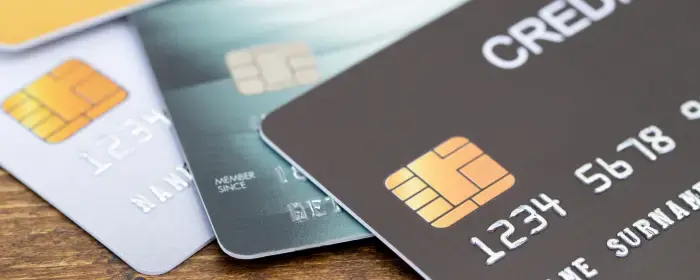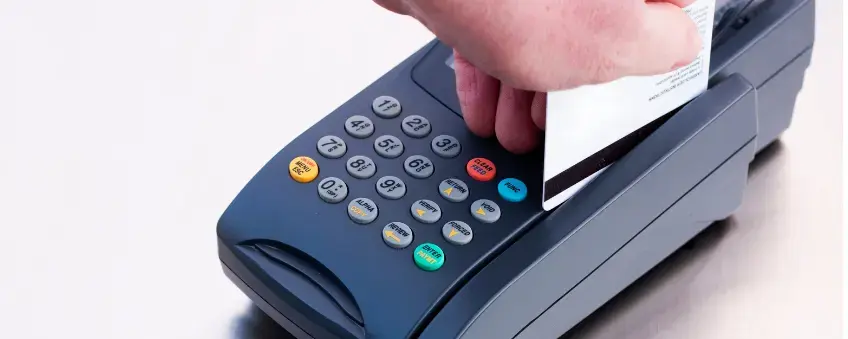Accepting debit and credit cards has become an essential part of modern business. Your customers expect to be able to use them, and declining that option can take a real toll. Up to 42% of customers will refuse to make a purchase if their preferred payment option isn’t available. (Source). So, the question isn't whether you should accept credit and debit cards but how much it should cost to access them. Once you understand credit card processing fees and rates, you can better adjust your pricing to meet your needs. So, let’s explore them in detail below.
What Are Credit Card Processing Fees?
Credit card processing fees are the costs associated with accepting credit and debit cards at your business. Each time you accept a debit or credit card, your business will be subject to various fees. They cover things like access to the card networks, bandwidth usage, security, encryption, and the movement of capital.
The total costs vary by business, pricing structure, and credit card processor, but you can expect to pay an average of around 1.5% to 3.5% of your total credit card sales. (Source)
While this may sound like a lot if you operate with tight margins, it’s important to recognize two things: first, you can and should build the costs into your pricing. Most merchants opt to add it in a small charge to account for fees, and some also offer cash discounts to incentivize cash purchases. Second, most merchants make far more sales once they shift to accepting credit cards. After the adjustment, businesses report an increase in revenue of roughly 20%. (Source). Generally speaking, it’s well worth the added expense.
As we alluded to, each transaction triggers a variety of fees. To clarify, there are three major categories of fees these will fall under. Interchange fees, assessment fees, and payment processor fees. Let’s break these down:
Interchange Fees
Interchange fees are the processing fees you pay to the card-issuing banks. The company that issued your customer’s card (most often, their bank) will collect this payment.
This portion of the total fee pool is generally the largest one. You can reasonably expect that anywhere from 50-70% of the credit card processing fees you pay fall into this category (depending on your pricing structure and the types of cards you accept). There are roughly 300+ rates any single transaction could fall under, and the exact interchange rate is determined by things like:
- Type of card. For example, business cards cost more than debit cards, and rewards cards can cost more to accept than a standard consumer credit card, etc.
- Entry mode. In-person payment modes are generally cheaper than online or manually entered transactions (due to the higher risk of fraud with those types). So, if you choose to manually key in a card number instead of swipe/tap it in person, for example, you, as the merchant, can expect to pay a higher interchange fee for the transaction.
- Your business type. Different rates apply to different types of businesses (determined by MCC codes). For example, restaurants and retailers can expect to pay a little more than 501(c)3 nonprofits, and travel or hospitality businesses can expect to pay a little more than restaurants and retailers.
- Transaction amount. While not always considered, exceptionally large transactions may be more expensive than smaller ones.
Assessment Fees
Assessment fees, on the other hand, are the fees that go directly to the card brands/networks. You’ll recognize the card brands as Visa, MasterCard, and Discover. They take what is generally the second largest chunk of the fees you pay each month (of course, depending on your payment processor.)
These fees cover access to the card associations and networks. The exact card brand access fees or assessment fees you’ll pay will vary depending on things like:
- The total processing amount. Each card brand charges a base association fee between 0.11% and 0.15%, and some add a fee (like the Visa FAN Fee) each month based on your total volume under their umbrella.
- Card origin. If the card is used in the US but issued in another country (more common in touristy areas), you may pay an extra assessment fee for accepting it.
- Number of requests. Each piece of data requested (like address verification, CVV code, etc.) adds to the overall bandwidth the transaction takes.
Payment Processor Fees
The third piece of this puzzle is the payment processor's fees. These fees go directly to the merchant service provider you signed an agreement with to cover things like your merchant account, access to their network partnerships, and their processing costs (like servers, security, support, etc.).
Typically (though not always), the amount the merchant services provider/payment processor gets to keep is the smallest piece of the overall pie. Typically, 10-20% (depending on your processor and pricing structure).
Other Fees
There are additional fees you may find on your statement that don’t fall under any of these categories, including things like:
- A payment gateway fee. This fee gives you access to a payment gateway (often requiring a third-party agreement through a company like Auth.net).
- Chargeback fee. This fee comes after a customer issues a formal dispute against your business and doesn’t believe you’re owed the funds for one of several reasons. It’s an administrative fee that covers the mini-court case over who rightfully deserves the funds.
- Early termination fee. This fee can be issued if you end your relationship with your merchant service provider before your contract expires.
How Do Credit Card Processing Fees Work?
Each time you accept a debit or credit card, you send signals between your customer’s bank, your bank, and your merchant account. Depending on the processing conditions and the card used, these signals carry varying degrees of weight and risk.
Understanding the Different Pricing Models
Now that you understand the fees you’ll be subject to, it’s essential to understand the varying pricing structures different credit card processors may offer you.
As you now understand, card-issuing banks and card brands assess most of the fees you’ll pay. This means that every payment processor has the same exact base costs. Credit card processors can only increase their profit margin by bundling the amount you pay differently, so you can’t see their markup. Let’s talk about how to avoid that.
Flat-rate Pricing
Flat-rate pricing is the least transparent pricing (in other words, it’s the hardest pricing structure to see the processor’s profit margin). With a typical flat rate pricing structure, you’ll be subject to one or two rates that bundle all the fees together. For example, if you have a 3.50% flat rate, and a transaction falls into an all-in 2.50% cost assessed by the card brands/card-issuing banks, your payment processor’s margin is 1.00%. If, on the other hand, the cost is lower (as is the case with regulated debit, for example), their fee for the transaction may be less than 0.50%, making their profit margin on that transaction 3.00%.
With this pricing structure, predicting your fees is easy, but you have no transparency. The ease of prediction makes it an easy sell, but hopefully, you can now see why it’s such a popular structure on the processor’s side, too.
Tiered Pricing
Tiered pricing is like flat-rate pricing in many ways, but it bundles the 300+ potential rates into three or four buckets. You’ll see a lower rate on “qualified” transactions and a higher rate on “non-qualified” or “mid-qualified” transactions. However, there’s no transparency as to which transactions qualify for which tier, making this only slightly more transparent than other structures.
Interchange-plus pricing
This is by far the most transparent pricing structure because it passes the interchange and association fees to you at cost and offers a disclosed markup from your processor on top. This is the gold standard pricing structure in the payments industry (and it is the one most likely to be in your favor as a merchant).
Membership-based pricing
An emerging trend in payment processing is membership-based pricing, offered by companies like Stax. Their fee varies based on your processing volume but starts at $99 per month. According to their website, they pass costs through to you with 0% markup, and their “disclosed markup” is $99 per month for merchants that process less than $120,000 per year. This makes their profit margin at least 0.99% (higher if you process less), which is considered high for this industry. (Source)
Average Credit Card Processing Fees From Card Networks
As I'm sure you now realize, the total average costs for credit card processing fees vary by business, pricing structure, and credit card processor. But you can anticipate paying an average of around 1.5 to 3.5% of your total credit card sales, all in. (Source)
How to Calculate Credit Card Processing Fees
To calculate what you’re paying for credit card processing fees regardless of your pricing structure, you’ll want to calculate what’s known as an effective rate. An effective rate is a fancy way of saying the total average rate.
To calculate it, you simply divide the total fees paid by the total amount of your credit card transactions during the same month.
For example, if you paid $300 for $10,000 worth of credit card volume (excluding sales made with cash), your effective rate is $300/$10,000 = 0.03 or 3.00%.
Note: Some processors take your fees out of each day’s sales, so this process may be a little harder to do, but the same principle applies.
Tips for Lowering Credit Card Processing Fees
To reduce your credit card transaction fees, there are a few key things you’ll want to consider that include:
- Getting quotes from multiple providers and negotiating between them.
- Understanding applicable fees so you know which ones are made up, which are legitimate, and which are avoidable.
- Encourage your customers to pay in person whenever possible.
- Passing the fees to your customers (there are a few ways to do this).
- Monitor your processing habits and keep chargebacks to a minimum.
- Avoid flat-rate pricing if possible.
Now, let’s look at each of these in a bit more detail.
Get Quotes From Multiple Providers and Negotiate
Don’t just take the first merchant services provider's word and end your search. It’s important to scour for at least a few reference points to get the best rates. This can be tricky to do because of the different pricing structures companies can offer (making it more like an apples-to-oranges comparison). Still, ultimately, your best ally is more information.
Be Aware of Hidden Fees
Many hidden fees sound legitimate but aren’t.
For example, one of the biggest scams in this industry today is the “noncancellable equipment lease.” It’s usually added to your merchant services agreement (so you may not notice it immediately) and gives you your processing equipment for something like $30-$50 per month (sometimes more).
Usually, these agreements have a 3-year payment plan, meaning you end up paying ~$1000 to $1800 for a piece of equipment worth $100-$500, and you don’t even own it at the end. No matter what, purchasing your equipment (even if you split the payment) is almost always better than renting it.
Encourage In-Person Payments
As we’ve mentioned a few times, it’s usually more expensive to process cards remotely, whether in-person, manually keyed, via eCommerce transaction, or a mail order/telephone order.
Having the customer pay with a physical card (or mobile wallet) in person is much more secure than the options mentioned, making it a bit cheaper to process.
Pass Credit Card Fees to Customers
There are several ways to pass on credit card fees to your customers legally (though some options vary from state to state, so be sure to check with your state before implementing some of these ideas). The ways you can pass these credit card fees to your customers include:
- Create a debit or credit card surcharge (if legal in your state – check with your state government for rules concerning surcharging) (Source).
- Build credit card processing costs into the price of your goods/services.
- Offer cash discounts to incentivize customers to use cash when possible.
Keep Chargeback Rates Low
You can reduce chargebacks by reducing your chargeback risk. To do that, make sure you:
- Offer good customer service.
- Keep open communication.
- Sell only just-as-advertised products and services.
- Put in fraud and security checks.
Take these precautions, and you’ll drastically reduce your risk of chargebacks.
Avoid Flat-rate
The flat rate pricing structure is popular thanks to companies like Square, Stripe, and PayPal. Still, they have the least transparent pricing structure, allowing these companies to bundle their markup into one rate, meaning you may be paying far more than necessary to their benefit, and your detriment, and with no way of knowing for sure. You can minimize your costs by partnering with a trustworthy payment processor and creating the right plan for your business.
Frequently Asked Questions
The merchant accepting debit and credit cards pays the credit card transaction fees directly. But many merchants choose to pass that cost on to customers through one of several ways, including:
- Accepting cards in person and by running the card/mobile wallet through your machine (i.e., not manually keyed in) whenever possible
- Practicing good processing habits. Some of the more expensive transactions come from poor processing habits, which include not settling your batch daily, skipping terminal/POS prompts, reducing security/increasing transaction risk by not asking enough questions at checkout (mostly for online transactions), etc.
- Reduce chargeback risk. You'll drastically reduce your risk of chargebacks by offering good customer service, open communication, and just-as-advertised products and services.
- Require a minimum transaction amount. For example, you can require a minimum of a $10 transaction before you accept cards, which reduces fees (the lower the dollar amount, usually the higher the percentage of fees you’ll pay).
- Create a debit or credit card surcharge (if legal in your state – check with your state government for rules concerning surcharging) (Source)
- Build credit card processing costs into the price of your goods/services.
- Offer cash discounts to incentivize customers to use cash when possible.
There are several ways to pass credit card fees to your customers. Which of them is legal depends on the state regulations in the state you’re operating in and you're accepting the debit and credit card(s).
A direct surcharge is an easy way to pass credit card fees to customers, but in many states, it is not legal because it unequally penalizes customers.
In most states, cash discounts are a legal way to incentivize payment with cash without triggering the surcharging laws. For the clearest, most up-to-date regulations, contact your state’s attorney general’s office for more information about your rights as a merchant.
There are several reasons credit card processing fees can sometimes be high, including things like:
- Transactions processed incorrectly. If prompts are skipped on the terminal/POS system, batches fail to close in a timely manner, etc., you can expect to pay a higher amount for the transaction.
- CNP vs. CP. CNP stands for “Card Not Present,” and CP stands for “Card Present.” CNP costs more and denotes any transaction processed without tapping, swiping, or dipping directly. So online transactions, over-the-phone transactions, and even card-present manually entered transactions are classified as CNP, which can add to the cost.
- High-end rewards or corporate cards. Accepting high-end rewards or corporate cards can add to the cost of the transaction.
Technically, there is no maximum merchant fee you could be charged for accepting credit cards. There is minimal regulation in this regard (though the Durbin Amendment sets maximum limits for what could be charged to your credit card processor for regulated debit cards). If you’re on a flat rate or less transparent pricing structure, you won’t benefit from this regulation). Ultimately, whatever agreement you sign with your merchant services provider dictates the maximum amount they can charge you for credit card merchant fees.






